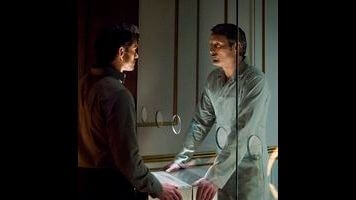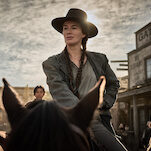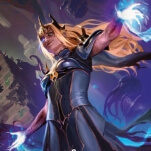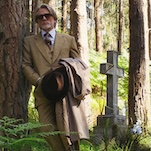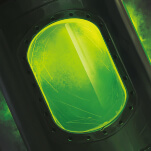Dolarhyde begins his portion of the episode by talking to Hannibal, sitting with him as if they are patient and doctor, much like Will and Hannibal worked in the early part of their relationship. “Your speech is bent and pruned by disability, real and imagined,” Hannibal tells him. “Your words are startling.” Dolarhyde’s status as an outcast is completely self-imposed. He makes himself the freak. That’s mirrored in his conversation with Reba. He is so concerned if others have discussed with her what his face looks like, but she assures him that others see his own self-consciousness as unnecessary and false. “You’re very sensitive about your face but you shouldn’t be,” she says about how others perceive him. Reba cannot see what pushes Dolarhyde his perception of himself to become the Red Dragon — his hairlip, his tattoos. He’s mysterious, she say, people wonder about him. To her, he is a blank slate, and a romantic partner. Dolarhyde perceives Reba as the woman clothed in the sun, his sexual conquest, but in the painting that woman is also the Red Dragon’s downfall. The Red Dragon continues to call to him. It’s why he must literally consume it.
“I want to be recognized by you,” Dolarhyde tells Hannibal, and he reveals his Red Dragon form. “Did he who made the lamb make thee?” Hannibal says, taking a line from William Blake’s most famous poem, “The Tyger.” The poem plays with the same themes that Hannibal plays with — this duality of self. In “The Tyger,” Blake contrasts the majestic beauty of the beast at hand with its ferocious nature. Reba only sees the beauty of Dolarhyde through his actions — taking her to the zoo to see the sedated tiger — she does not know what he contains. When she gets too close to the tiger’s mouth, Dolarhyde winces. She’s getting to close to this ferocity. In the line that Hannibal speaks — “Did he who made the lamb make thee?” — there’s also a duality. How could the creator make a creature such as the sweet lamb and the killer tiger?
That duality is best seen through Bedelia who looks so sweet and innocent because that is the story she allows others to believe about herself. She did not willingly take part in Hannibal’s plans, she was psychologically manipulated into doing so, or at least that’s what she says. In Bedelia’s view, she was never out of control. Her part in the story was to play the part that Hannibal needed her to play as the covert, and cooperative psychiatrist. She asks Will: When you see a wounded bird, what do you think of it? “It’s vulnerable, I want to help it.” he says. “I also think it’s vulnerable and yet, I want to crush it,” she icily replies, as only Bedelia can. Perhaps, her own controlled duality is why she and Hannibal got along so well. On the outside, they are both put-together and patrician. On the inside they are monsters.
This scene between Will and Bedelia, and eventually Zachary Quinto, was one of my favorite in the series, as the two discuss their true nature and Bedelia reveals herself, and the circumstances behind her relationship with Hannibal. The intercutting of the scenes with Quinto was seamless, fantastic, and entirely unexpected. Throughout Bedelia’s tenure, it has been made clear that the patient that died under her care had attacked her, and her hand was forced. Yet, that’s not true, her hand literally only did her own bidding. There was a sexual component to Bedelia sticking her arm down Quinto’s character’s throat, as if she was defiling in a way behind playing with his mind, as Hannibal was doing. (Bedelia played with quite a bit of innuendo throughout the episode. While there has consistently been a homoerotic bent to Hannibal and Will’s relationship, Bedelia made sure to highlight that as much as possible, using words like “passion” and “old flames,” taunting Will with what Molly does and does not know about his relationship with Hannibal.) Quinto’s character was wounded, and she did not feel the need to save him.
Will is not what Hannibal and Bedelia are, even if he believes himself to be at one with them. Bedelia, through her own ice queen evilness, actually does Will a service. “You are capable of righteous violence because you are compassionate,” she tells Will. And she? “Extreme acts of cruelty require a high level of empathy,” she says. “The next time you have an instinct to help someone, you might consider crushing them instead. It might save you a great deal of trouble.” Fo so long, Will saw himself at one with Hannibal, but it was he was in fact Hannibal’s opposite, not his complement. How Will has seen Bedelia all along has been wrong, and more importantly, so is how Will has seen himself.
Stray observations
- Recipe of the week: Tiger Butter Fudge
- Fun fact: The first time I ever heard “The Tyger” was the Batman: The Animated Series episode “Tyger, Tyger.”
- The collar of Bedelia’s dress? DIVINE.
- SPOILERS FOR THOSE WHO HAVEN’T READ THE BOOK/SEEN THE MOVIE. STOP READING NOW: Francis also picks his victims through perception. He sees the happy photos of happy families that he develops, and chooses them based on this idea that they are better than he is. But those are just images and not reality.
